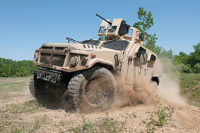The typical U.S. soldier carries more than 100 pounds of gear when in the field. Heavy loads increase the likelihood of musculoskeletal injury and also exacerbate fatigue, which contributes to both acute and chronic injury and impedes soldiers’ physical and cognitive abilities to perform mission-critical tasks.
Lightweight exoskeletons currently under development will give soldiers superhuman strength. For instance, Lockheed Martin recently created a device called the human universal load carrier (HULC). The hydraulically powered HULC features a titanium frame that allows soldiers to easily carry loads of up to 200 pounds.
The Defense Advanced Research Projects Agency (DARPA) is also tackling the challenge by developing a comfortable, lightweight undersuit that would help prevent injury and boost endurance.
The Warrior Web project aims to protect injury-prone areas and promote efficient and safe movement over a wide range of activities, such as walking, running, jumping and crawling. Comfortable, durable and washable, the garment would not interfere with body armor or other standard clothing and gear, while using no more than 100 watts of power.
“Many of the individual technologies currently under development show real promise to reduce injury and fatigue and improve endurance,” says lieutenant colonel Joseph Hitt, DARPA program manager for Warrior Web. “Now, we’re aiming to combine them into a single system that nearly every soldier could wear and would provide decisive benefits under real-world conditions.”
Engineers at DARPA have been focusing on methods for rapid joint stabilization, functional structures, energy injection, regenerative kinetics, load transfer and distribution, and flexible kinetic and kinematic sensing.



